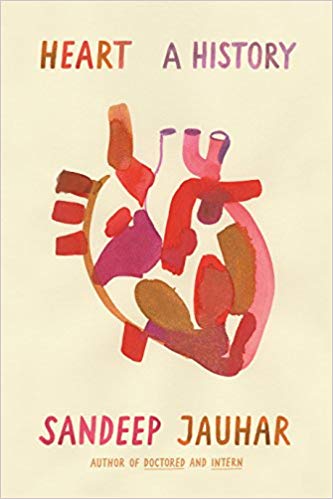Sandeep Jauhar
Farrar, Straus and Giroux
New York
2018
269 pages
According to the Art:
Sandeep Jauhar describes a select set of historical events that tend toward the triumphant while leaving aside some of the reversals and catastrophes that have historical importance. His views of future advances in cardiology are pessimistic even as cellular and gene therapies are moving into clinical trials at the time he writes this book.
Synopsis:
The author, Sandeep Jauhar, attributes his “obsession” with the human heart to family history, which includes fatal heart attacks that took both of his grandfathers from him, and to the beginnings of his own coronary artery disease revealed on screening tests. That he became a practicing cardiologist, though after first becoming a PhD-level theoretical physicist, is no surprise then.
It was this obsession with the heart and his chosen profession that drove him to write this book, which he says, “is about what the heart is, how it has been handled by medicine, and how we can most wisely live with—as well as by—our hearts in the future.” (p. 10) In form, the book is a series of brief accounts of selected events in the history of medicine involving the human heart and circulatory system, interwoven with personal anecdotes and reflections.
Some of the historical events and developments include how the heart and circulatory system work, and the methods used to assess how well they are working such as echocardiography and coronary catheterization. How heart-lung bypass, first person to person then mechanical, made cardiac surgery possible is described, as are many of the surgical procedures it enabled to treat coronary artery disease and to replace malfunctioning valves. Nonsurgical procedures Jauhar explains encompass those for intervening during acute heart attacks (e.g., angioplasty, stents, thrombolysis), managing life-threatening heart rhythm disturbances (e.g., external and implantable pacemakers and defibrillators, radio-frequency ablation), and replacing parts or all of the heart (e.g., coronary artery bypass, heart valve replacement, left ventricular assist devices, heart transplant). Little mention is made about the use of drugs despite having contributed to both important advances and surprising failures in heart disease.
Topics related to the heart indirectly include the effects of emotions and psychological problems (e.g., stress), social determinants of disease (e.g., social economic status), and wellness concepts (e.g., diet, exercise). Some history of heart disease and the reduction of deaths from it over the past several decades are also touched upon. Parts of the book take the form of memoir, which add to his previous two books (Intern: A Doctor’s Initiation, and Doctored: The Disillusionment of an American Physician).
Analysis:
Heart, a History is more a collection of stories about individual events and people than a volume of historical research. Jauhar writes with the perspective of a passionate practitioner and enthusiastic advocate for his clinical specialty.
Perhaps more than any other area of medicine, cardiology has been at the forefront of technological innovation and quality improvement over the past fifty years. This golden period has witnessed a barrage of life-prolonging advances, many of them discussed in this book… Preventative health initiatives, such as smoking cessation and cholesterol and blood pressure reduction, have supplemented these biomedical advances. The result has been a sixty percent drop in cardiovascular mortality since 1968.
p. 238
In his tribute to cardiology Jahaur does not acknowledge a school of thought that attributes the drop in coronary disease to some unknown biological process rather than solely to the technological innovations he hails. The spike in deaths from coronary disease began in the 1930s, peaked in the 1950s, and then began a dramatic decrease in the 1960s, which was before many of the interventions Jahaur describes were in place. This trajectory of coronary disease mortality resembles what has been seen in some infectious epidemics (think tuberculosis): they come, and then they go, independent of what modern medicine does.
Despite his exhilaration about how far cardiology has come and what it has achieved, Jauhar fears its golden period is over: “Cardiology in its current form might have reached the limits of what it can do to prolong life” (p. 239). Yet, when he was writing of his despair over the diminishing prospects of cardiology, long-dreamed-of therapeutic approaches were starting to look realistic with genetic and regenerative technologies for heart diseases under evaluation in clinical trials.
In summing up his reflections on the history of the human heart and the meanings they have for the future, Jauhar echoes the current emphasis on preventative measures:
We will need to shift to a new paradigm, one focused on prevention…to continue to make the kind of progress to which patients and doctors have become accustomed. In this paradigm, psychosocial factors will need to be front and center in how we think about health problems…today it is increasingly clear that chronic diseases like hypertension, diabetes, and heart failure are inextricably linked to the state of our neighborhoods, jobs, families, and minds.
p. 240
Readers who are interested in the impact of heart disease and in some of the significant historical events related to the human heart will likely best appreciate Heart: A History.
Also:
A version of this review is posted on the NYU Literature, Arts and Medicine Database.



